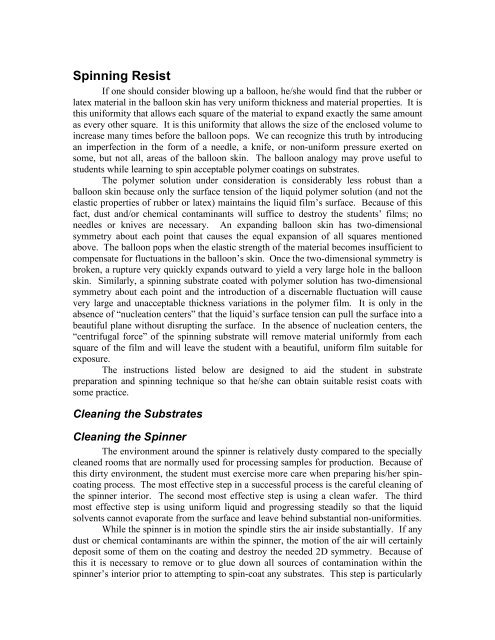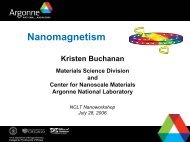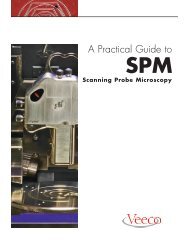You also want an ePaper? Increase the reach of your titles
YUMPU automatically turns print PDFs into web optimized ePapers that Google loves.
Spinning Resist<br />
If one should consider blowing up a balloon, he/she would find that the rubber or<br />
latex material in the balloon skin has very uniform thickness and material properties. It is<br />
this uniformity that allows each square of the material to expand exactly the same amount<br />
as every other square. It is this uniformity that allows the size of the enclosed volume to<br />
increase many times before the balloon pops. We can recognize this truth by introducing<br />
an imperfection in the form of a needle, a knife, or non-uniform pressure exerted on<br />
some, but not all, areas of the balloon skin. The balloon analogy may prove useful to<br />
students while learning to spin acceptable polymer coatings on substrates.<br />
The polymer solution under consideration is considerably less robust than a<br />
balloon skin because only the surface tension of the liquid polymer solution (and not the<br />
elastic properties of rubber or latex) maintains the liquid film’s surface. Because of this<br />
fact, dust and/or chemical contaminants will suffice to destroy the students’ films; no<br />
needles or knives are necessary. An expanding balloon skin has two-dimensional<br />
symmetry about each point that causes the equal expansion of all squares mentioned<br />
above. The balloon pops when the elastic strength of the material becomes insufficient to<br />
compensate for fluctuations in the balloon’s skin. Once the two-dimensional symmetry is<br />
broken, a rupture very quickly expands outward to yield a very large hole in the balloon<br />
skin. Similarly, a spinning substrate coated with polymer solution has two-dimensional<br />
symmetry about each point and the introduction of a discernable fluctuation will cause<br />
very large and unacceptable thickness variations in the polymer film. It is only in the<br />
absence of “nucleation centers” that the liquid’s surface tension can pull the surface into a<br />
beautiful plane without disrupting the surface. In the absence of nucleation centers, the<br />
“centrifugal force” of the spinning substrate will remove material uniformly from each<br />
square of the film and will leave the student with a beautiful, uniform film suitable for<br />
exposure.<br />
The instructions listed below are designed to aid the student in substrate<br />
preparation and spinning technique so that he/she can obtain suitable resist coats with<br />
some practice.<br />
Cleaning the Substrates<br />
Cleaning the <strong>Spinner</strong><br />
The environment around the spinner is relatively dusty compared to the specially<br />
cleaned rooms that are normally used for processing samples for production. Because of<br />
this dirty environment, the student must exercise more care when preparing his/her spincoating<br />
process. The most effective step in a successful process is the careful cleaning of<br />
the spinner interior. The second most effective step is using a clean wafer. The third<br />
most effective step is using uniform liquid and progressing steadily so that the liquid<br />
solvents cannot evaporate from the surface and leave behind substantial non-uniformities.<br />
While the spinner is in motion the spindle stirs the air inside substantially. If any<br />
dust or chemical contaminants are within the spinner, the motion of the air will certainly<br />
deposit some of them on the coating and destroy the needed 2D symmetry. Because of<br />
this it is necessary to remove or to glue down all sources of contamination within the<br />
spinner’s interior prior to attempting to spin-coat any substrates. This step is particularly
important if the spinner has been idle (and is therefore more dusty). Additionally, the<br />
spinner interior will acquire dust at a lower rate if the contents of the fume hood are also<br />
clear of dust and contamination.<br />
1) Open the vacuum valve that connects the spinner to the house<br />
vacuum.<br />
2) Open the nitrogen tank main valve and set<br />
the nitrogen pressure to 65 psi.<br />
Increase<br />
Decrease<br />
3) Put on a clean pair of gloves and verify<br />
that sufficient acetone and isopropyl alcohol are<br />
available.<br />
4) Before bringing chemicals near the spinner, completely<br />
cover the o-ring with a waste wafer fragment and<br />
activate the vacuum chuck to keep it firmly in<br />
place. This wafer, if correctly installed, will<br />
prevent chemicals from entering the spinner<br />
vacuum port and spoiling the spinner’s bearing<br />
lubrication. Do not use the spinner if it is possible<br />
that chemicals have been admitted to the vacuum<br />
port… doing so will ruin the spinner and will<br />
yield very poor results.<br />
5) To clean the spinner spindle, soak the outside<br />
portion of the substrate holder with acetone and<br />
keep wet for 20 s. Use as little acetone as<br />
possible while keeping the surface wet. Acetone<br />
will dissolve the rubber o-ring, so be careful that<br />
the two do not meet.<br />
No<br />
Acetone
6) After 20 s acetone soak, flood the spindle with<br />
isopropyl alcohol (IPA) beginning at the waste<br />
wafer center and working outward. Begin this<br />
step while the acetone is wet and keep the spindle<br />
wet for 30 s so that the IPA can dissolve the<br />
acetone residue.<br />
Alcohol<br />
7) Close the lid and start the spinner.<br />
8) After the spinner stops, lift the lid, deactivate the<br />
vacuum chuck, and<br />
carefully remove the<br />
waste wafer and the<br />
o-ring. Please do not<br />
scratch the o-ring<br />
grooves because any<br />
scratches will<br />
prevent a good<br />
vacuum seal and will<br />
tilt the substrates in the future.<br />
9) Carefully and thoroughly wipe the spindle and o-<br />
ring groves with tissue or cloth. If any loose<br />
polymer ends are observed, carefully pull away<br />
as much old polymer as possible with tweezers<br />
and discard in the trash. Wipe the waste wafer<br />
and o-ring clean with tissue or cloth.<br />
O-Ring<br />
Grooves<br />
10) Using the nitrogen nozzle, blow away debris from<br />
the o-ring groves and spindle. If any loose polymer ends are observed, carefully<br />
pull away as much old polymer as possible with tweezers and discard in the trash.
11) Carefully replace the o-ring in its groove and replace the waste wafer fragment so<br />
that the o-ring is completely covered. Re-engage the vacuum chuck.<br />
12) Wipe the remaining spinner interior clean with tissue or cloth. If poor results are<br />
observed, dampen the tissue with DI water before wiping the spinner interior. For<br />
more extreme cases, use Liquinox and water to wash the interior before<br />
thoroughly rinsing away the Liquinox with DI water. Acetone will dissolve the<br />
plexiglass top, so do not use acetone close to the spinner top.<br />
13) Allow solvents to evaporate. If no other cause can be found for poor results,<br />
suspect the presence of solvents and allow more drying time.
Applying PMMA<br />
14) De-activate the vacuum chuck and replace the waste wafer with a clean substrate.<br />
Reactivate the vacuum chuck. Blow away debris from the top and bottom of the<br />
spinner interior using the pressurized nitrogen nozzle. Close the spinner lid.<br />
15) Remove the stopper in the spinner top and blow<br />
away debris from the substrate and spindle.<br />
16) With minimal delay, apply several drops of PMMA<br />
to the substrate so that the surface is completely<br />
covered, start the spinner, and replace the stopper in<br />
the spinner hole.
17) Examine the completed coat for defects. A good coat will have uniform color<br />
(usually blue, green, or purple depending upon the coat thickness) except very near<br />
the substrate edges. Proceed to baking or to cleaning and re-coating as the spin<br />
quality dictates.<br />
18) Dispose of waste. Place glass and sharp objects like razor blades in the safety<br />
approved container. Place paper, old gloves, etc. in the wastebasket. Place waste<br />
chemicals in the gallon container provided. Wash glassware with soap and water in<br />
the sink, rinse thoroughly, and wipe dry.
















